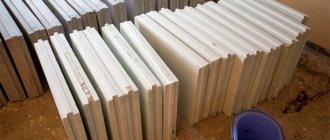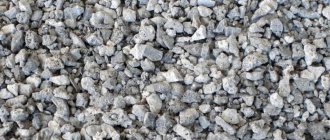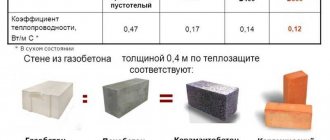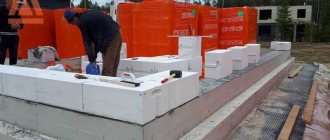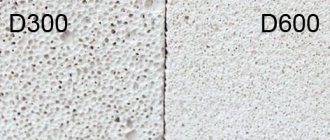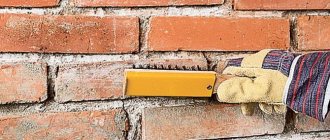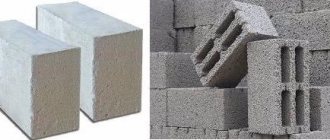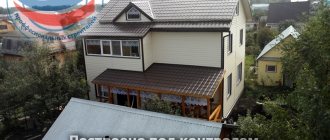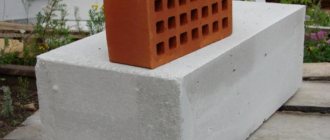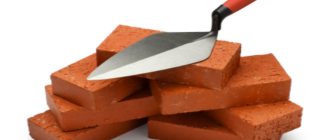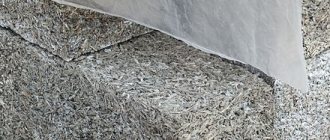home
Catalog
Production and use of gas silicate blocks
The price of gas silicate blocks is such that walls made from them are much cheaper in price and quality than brick walls. That is why gas silicate wall blocks have gained such popularity. In addition, the sale of gas silicate blocks is carried out by a large number of companies. Buildings made from aerated concrete are almost eternal and require no maintenance!
Currently, the choice of building materials is quite extensive: brick, wood, reinforced concrete, foam blocks, gas silicate block. It follows that we are not limited in our choice, but still, which material is better? Here we will tell you about perhaps one of the most effective and fairly inexpensive modern materials - gas silicate blocks.
Gas silicate blocks - what are they?
Gas silicate is an artificial stone made from a cellular concrete mass. It is possible to produce such building material on your own. You just have to mix the solution, pour it into the mold and leave it for several days to harden.
It is necessary to understand that the quality of the stone will leave much to be desired.
Most often, blocks are made using the autoclave method. Hardening of the concrete mass occurs under the influence of pressure and temperature, giving the product strength. This manufacturing method is the main one, because it allows the production of blocks in accordance with the requirements of GOST 31360 2007.
Features of brick
The brick can be silicate or ceramic.
Among the positive features of sand-lime brick are:
- frost resistance;
- sound insulation;
- strength;
- environmental friendliness;
- unpretentiousness.
If you decide to prefer ceramic products for construction, then the walls of the house will also be characterized by insignificant moisture absorption.
Before purchasing, you can choose any shape and color of the products.
Areas of use
Gas silicate blocks are a universal material used in various areas of the construction industry.
Light stones, the density of which is 200 kg per cubic meter, are used as insulation material.
Blocks with a density of 400 kg per cubic meter are a material for the construction of load-bearing walls in buildings not exceeding a three-story level, and partitions.
Denser material with a rating of 500 kg is used for the construction of objects whose height exceeds three floors.
Stones with an index of 700 kg/m3 are used in the construction of structures reaching a height of nine floors.
Specifications
It makes sense to look at the main technical characteristics of gas silicate material:
- The value of the specific thermal capacity of block material made using the autoclave method is 1 kJ/kg*°C. For comparison, the same figure for reinforced concrete stone reaches only 0.84.
- The density of reinforced concrete material is five times higher, but the thermal conductivity of the gas silicate block is only 0.14 W, and this figure can be compared with coniferous wood. For reinforced concrete, this coefficient is 2.04.
- The noise absorption of gas silicate is 0.2 if the sound frequency is 1,000 Hz.
- The frost resistance of blocks, the average density of which does not exceed 400 kg, is not standardized; for material with an indicator of 600 kg it reaches three and a half dozen freeze-thaw cycles. Denser stones can withstand up to fifty cycles. It turns out that the maximum service life of such gas silicate blocks is 50 years.
If we make a comparison between blocks and brick material, then the indicators will not be in favor of the second material. To obtain a sufficient level of thermal conductivity, a gas silicate wall must be at least fifty centimeters wide. And for brickwork this value is 2 meters. In addition, when masonry is made from blocks, the consumption of mortar mass is reduced significantly.
The weight of one square meter of masonry made of gas silicate material will not exceed two hundred and fifty kilograms, while a brick section will weigh about two tons. Here it should be taken into account that the thickness of the foundation will vary, which will also affect the expenditure of funding allocated for construction work. The compressive strength of both materials is so different that for gas silicate masonry a half-meter wide foundation will be enough, while for brick you will need a foundation a couple of meters wide.
Installation of block masonry is easy, which will reduce labor costs.
In addition to all that has been said, blocks are considered an environmentally friendly material. The coefficient for this item is such that gas silicate can be compared with natural wood. But for brick this value is 8 – 10 units.
Gas silicate: description, properties
A standard gas silicate block, which weighs more than 20 kg, has a size of 600x250x300 mm and a density of 500 kg/m3, in a 640 mm thick enclosing wall can replace 30 bricks weighing more than 120 kg. No special lifting mechanisms are required due to its low weight and relatively large dimensions of the gas silicate block, while the speed of construction increases (according to some estimates by 4 times) and labor costs become much lower. Add to this the low cost of gas silicate blocks - all this reduces the amount required to erect a building.
Gas silicate blocks, which are sold by our company at affordable prices, are easily sawed, nailed, processed with any cutting tool, and fined, which makes their use especially attractive.
Walls made of gas silicate block meet all new requirements of building codes and regulations (SNiP).
And also the main properties of the gas silicate block include heat-accumulation properties, i.e. By using this material you can significantly save on heating costs.
Production technology
Lime, sand and water, taken in certain proportions, are placed in a concrete mixer. After this, using a special dispenser, aluminum powder is poured into it. The mixture is laid out in molds and left for four hours at a temperature of forty degrees Celsius.
Calcium hydroxide begins to react with aluminum, actively releasing hydrogen. The raw material mass begins to foam and increase in volume, like yeast dough.
As soon as the evolution of hydrogen stops, the mixture becomes plastic. The finished array is divided into even blocks, which are sent to autoclave units. Under a pressure of 14 bar and a temperature of 180 degrees, the material is further dried.
The pores can contain up to eighty percent air, and this figure depends on the brand of gas silicate blocks. But quartz sand gives the blocks the necessary strength.
Main characteristics of gas silicate concrete and its classification
Many people do not see the difference between gas silicate and aerated concrete - this is a mistaken opinion. Although the manufacturing technique for these cellular materials is similar, there are still some differences. In both cases, aluminum powder is used as a blowing agent, which makes the mixture porous.
Gas silicate consists of such fillers:
- quartz sand – 62%;
- lime – 24%;
- aluminum powder.
The composition complies with the standards of GOST 25485-89 , as well as GOST 31359-2007 . After checking the alkalinity level of the mixture and adding aluminum paste or powder, vibration mixing occurs and the casting partially hardens. Subsequently, it is cut into blocks by string complexes and sent to an autoclave for final readiness. Under the influence of pressure and high temperature, a uniform distribution of pores is obtained, as well as their unification.
Thanks to the addition of finely dispersed elements and electrolyte additives to the mixture, which accelerate the process of formation of calcium hydrosilicates (NaOH, Na2SO4), a significant increase in strength . The frost resistance of silicate concrete is usually in the range of 35-50 cycles, but by lowering the molding humidity it is possible to increase the indicator to 100-150 cycles.
There is also a non-autoclave manufacturing method , but the weaknesses of such gas-silite blocks have forced almost all manufacturers to abandon this technology.
In turn, the production of aerated concrete is possible both by autoclave and non-autoclave methods. Moreover, the mixture, unlike gas silicate, contains cement in a proportion of about 60% of the total volume.
Depending on the purpose, cellular concrete is divided into three types :
- thermal insulation – construction of openings, thermal insulation of walls (density 350-400 kg/m³);
- thermal insulation and structural – construction of one- and two-story buildings, insulation (density 500-900 kg/m³);
- structural – construction of load-bearing structures of buildings 3-5 floors high (density 900-1200 kg/m³).
Thermal insulation blocks are distinguished by their thermal conductivity and density, which is why they are most often used in private construction. Material grades D-500, D-600, due to their good price-reliability ratio, are most in demand in the construction of suburban houses.
Manufacturers
The following companies are popular among manufacturers:
- Kaluga aerated concrete plant;
- Ivanovo silicate plant;
- Yegoryevsk Construction Materials Plant;
- Orsha plant;
- Kostroma and Stary Oskol plants.
Gas silicate blocks made in Raduzhny, Baranovichi, Novomichurinsk, and Liski are known for their quality.
Among the gas silicate material itself, many consumers prefer to choose blocks of the brands Poritep (Poritep), Itong, Eco, Drauber, Hebel.
At enterprises considered leaders in the production of block materials, European-level equipment is installed, modern technologies are used, and stage-by-stage control over product quality is organized.
Advantages and disadvantages
The advantages of gas silicate material include the following positive qualities:
- Light weight - no need to use loading and unloading equipment. Having a masonry tool, you can carry out construction work yourself;
- numerous void spaces guarantee excellent insulation from extraneous noise;
- blocks are easily processed with manual materials - a hacksaw, grater, etc.;
- low level of thermal conductivity - the house will be warm, a comfortable microclimate will always be maintained indoors;
- construction work is completed quickly because the blocks are large in size. If there is a special grip, the block is convenient to move and stack;
- the material belongs to the group of low-flammable materials.
Objects made from such material are comfortable and environmentally safe. The excellent vapor permeability of the blocks allows the walls to “breathe”. But a house made of such material is built on two floors, and if the gables are high, then on one. Otherwise, the lower rows of masonry may collapse from the heavy weight.
In addition to positive qualities, there are also negative aspects. The block is considered a non-combustible material, but can be destroyed when exposed to high temperatures. A severe fire will make an object made of gas silicate material unsuitable for further use.
Another problematic issue is moisture absorption. Water that gets onto an aerated concrete surface almost immediately ends up inside the stone. During severe frosts, “wet” blocks may crack. To protect the material from excess moisture, water repellents are used.
Builder reviews
Each developer has his own experience in using such material. There is nothing easier than making a garage from aerated silicate bricks or building a wall of a house. Most developers note the numerous advantages of the objects, citing first of all comfort, moderate air humidity, warmth, and acceptable financial costs.
But if the known experience is negative, then often the reasons are hidden in technology violations. For this reason, experienced builders recommend:
- competently determine the scope of application of existing brands of gas silicate material;
- check building materials before purchasing. First of all, ask how much aerated silicate bricks cost. Manufacturers supply gas silicate with indentations from GOST requirements, with chips on the edges and wavy surfaces;
- when constructing multi-storey buildings, it is necessary to provide for the installation of reinforcing columns;
- a prerequisite is the installation of external cladding.
The material is of high quality and reliability, and its design features have deservedly made it popular.
Gas silicate building brick is considered a technological material. Using it, it becomes possible to form a variety of geometric designs, even rounded ones. Strength and lightness make it possible to often use this material in individual construction, significantly speeding up the work process.
betonov.com
